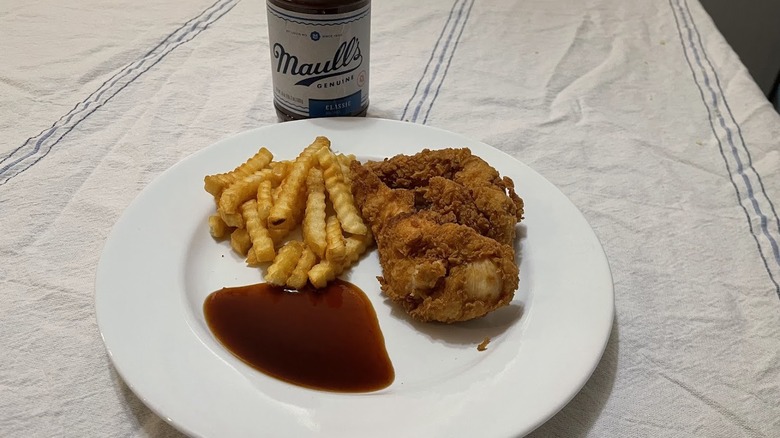The St. Louis-Style Barbecue Sauce That's An American Treasure
We may receive a commission on purchases made from links.
Though cooking techniques and protein preparation define American regional barbecue, the importance of barbecue sauce should not be overlooked. St. Louis-style barbecue, for example, is characterized by a vinegar-forward sauce paired with rectangular cuts of spare ribs. One of the prime examples of St. Louis-style barbecue sauce is Maull's, which has been in production since 1926. In contrast to the ketchup-adjacent thickness of Kansas City barbecue sauce, which defines most people's perception of the condiment, St. Louis-style sauce is a bit lighter and acidic. We likely have Maull's to thank for establishing that benchmark.
Originally created by St. Louis native Louis Maull, the brand Maull's has been a staple of barbecue culture for nearly a hundred years. In St. Louis barbecue vernacular, "Maullin' it" is shorthand for adding the popular sauce to one's cooking. In fact, Maull's is so beloved in its hometown that local news covered a "barbecue panic" that gripped St. Louis when the Maull's factory halted production due to financial troubles. Maull's was eventually purchased by Allied Investments, LLC which has kept the company afloat and the iconic barbecue sauce flowing.
Why Maull's is a St. Louis institution
So what makes Maull's sauce unique to St. Louis-style barbecue? For starters, it's designed to be added to the meat after it's been cooked. St. Louis barbecue primarily refers to the particular cut of pork spare ribs cut in a rectangular shape to retain more meat on the bone. In contrast to the baby back ribs that are more popular in Kansas City barbecue, St. Louis spare ribs are meatier, fattier, and work better on a grill.
Maull's barbecue sauce would typically arrive as a tableside condiment once the protein has finished cooking, though it can definitely be used as a marinade if one were so inclined. A quick stroll through the ingredients list on a bottle of Maull's Classic Barbecue Sauce reveals a heavy hand with tomato concentrate made with distilled vinegar along with a hit of Worcestershire sauce, which is vinegar and molasses. For a kick, Maull's adds a bit of its own hot sauce, which applies a third dose of vinegar to the mix.
The final product puts Maull's barbecue sauce somewhere on the spectrum of regional barbecue sauces between the acidic Carolina versions and the thicker, tomato-based options from Kansas City. As I'm a fan of both styles of sauce, I was looking forward to giving Maull's a test drive of my own.
Maullin' it
I couldn't find Maull's at my local grocery stores as I'm pretty far from St. Louis, but I ordered some online with no problems. I was initially surprised by the thin consistency of the sauce. Like most people, I'm a bit more familiar with barbecue sauce that has the viscosity of tomato ketchup. That said, I liked that Maull's poured easily — make sure you give it a few shakes to get all that Worcestershire goodness evenly dispersed — and I could definitely see using this as a marinade in the future.
I started out by trying a bit of Maull's on its own and I can see why its potential disappearance caused St. Louis pitmasters to panic. It's the Worcestershire sauce that brings all the Maull's flavors together — it's smoky, spicy, and only a little bit sweet. I immediately understood how Maull's could really enhance a plate of barbecue, but I decided to see how it did outside of its natural habitat.
I ordered up some fried chicken fingers, as barbecue sauce on chicken is an equally delicious pursuit. After a few dabs, I was sold. The vinegar-heavy flavors work extremely well with the natural flavors of the protein. I also appreciated the subtle but spicy kick that Maull's imparts to the show. All in all, Maull's barbecue sauce really is that good. I can definitely understand why barbecue aficionados continue to stock their shelves with this American treasure.


